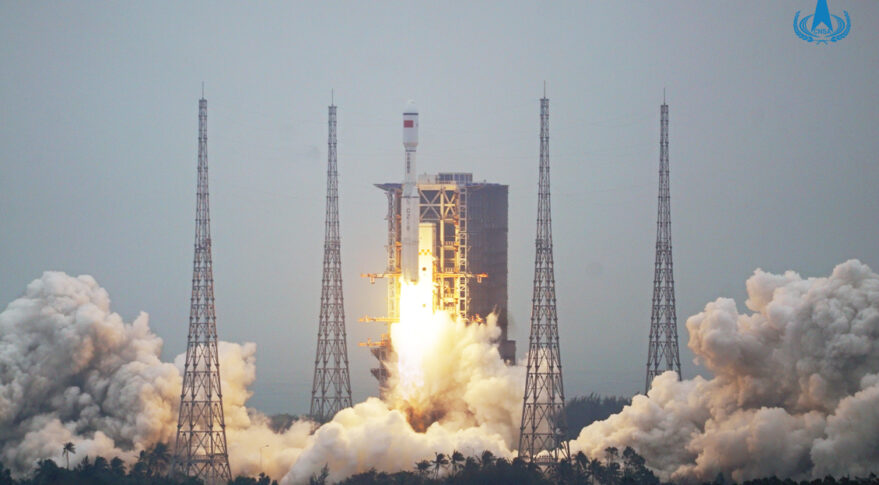China launches first Long March 8 from Wenchang spaceport
China launches first Long March 8 from Wenchang spaceport

HELSINKI — China successfully carried out a first launch of the new Long March 8 medium-lift rocket late Monday, marking a small step towards Chinese rocket reusability.
The 50.3-meter-long, 356-ton Long March 8 lifted off at 11:37 p.m. Eastern Dec. 21 from the coastal Wenchang launch site carrying five satellites into Sun-synchronous orbits. Launch was delayed two days due to weather.
State-owned defense contractor China Aerospace Science and Technology Corp. (CASC) confirmed launch success around 40 minutes later.
The Long March 8 combines the 3.35-meter-diameter Long March kerosene-liquid oxygen first stage with a 3-meter-diameter hydrolox second stage from the Long March 3A series.
The core stage is powered by a pair of YF-100 kerolox engines, while two 2.25-meter-diameter side boosters each use a single YF-100 engine.
The China Academy of Launch Vehicle Technology (CALT), a CASC subsidiary which designed and produced the launcher, states (Chinese) the new rocket fills the gap in China’s capability for launches to Sun-synchronous orbit in the 3-4.5 ton range.
The Long March 8 is, like the new generation Long March 5, 6, 7 launch vehicles, designed to replace and upgrade China’s aging hypergolic Long March 2, 3 and 4 families. The new launchers first began launching in 2015.
The Long March 8 is to be adapted for reusability in the future. During the launch thrust was throttled down to 77.5 percent around the time of maximum dynamic pressure.
“Thrust adjustment technology is a key technology for rocket reusability and must be mastered,” said Xiao Yun, the commander-in-chief of the Long March 8. Further tests related to vertical take-off and vertical landing are planned for 2021.
The main payload was XJY-7, a classified remote sensing technology test satellite developed by the China Academy of Space Technology (CAST). Mass of the satellite is understood to be around 3 tons.
First commercial SAR satellite
Four smaller payloads were also aboard. Haisea-1 is the first miniature synthetic-aperture radar (SAR) satellite for Spacety, a commercial Chinese satellite company founded in 2016.
Hisea-1 is a C-band SAR satellite using a phased-array antenna. I has a total mass of 180 kilograms and 1-meter resolution .
The China Electronics Technology Group (CETC) provided the SAR payload while Xiamen University was also involved in development of the satellite and payloads. The satellite will be used for coastal and marine research applications.
Spacety told SpaceNews that Hisea-1 is the first generation of light, small SAR satellites currently under development by the company. It aims to reduce mass to below 170 kilograms and resolution to better than 0.5 meters. The firm says it is China’s first miniaturized SAR satellite and also the country’s first commercial SAR satellite.
Spacety says it aims to build a SAR constellation with dozens of satellites across the next two-to-three years. Hisea-1 also carries an iodine electric propulsion system developed by French startup ThrustMe, continuing earlier cooperation with Spacety.
ThrustMe’s Ane Aanesland said the propulsion system will provide the satellite with crucial orbit maintenance, collision avoidance and deorbiting at the end of its three years expected lifetime.
Yuanguang is a 20-kilogram space science satellite developed jointly by Hubei University of Technology (HUT) and Spacety. The primary payload is a space tribology experiment form HUT to conduct experiments of mechanisms and tribology and investigate the change of mechanical properties at the level of material, component and system over flight time in space.
Zhixing-1A, also known as ET-SMART-RSS 6U nanosat, was developed in partnership between Ethiopia and commercial firm Beijing Zhixing Space Technology Co. Ltd. The final payload was Ping’an-1, also referred to as Tianqi Xingzuo-08. It is a satellite for commercial firm Guodian Gaoke’s Apocalypse Internet of Things constellation.
The launch was China’s 38th of 2020. CASC said in January that it aimed to launch around 40 times, before the severity of the impacts of the COVID-19 outbreak became apparent.
The 38 includes launches by non-CASC entities. Expace, under state-owned defense giant CASIC, launched four Kuaizhou solid rockets. The inaugural Kuaizhou-11 launch failed in July, while the smaller, established Kuaizhou-1A also failed in September. Galactic Energy became the second non-state-owned Chinese rocket company to reach orbit in November.
Comments
Post a Comment